Flaming Desserts, Ranked Worst To Best
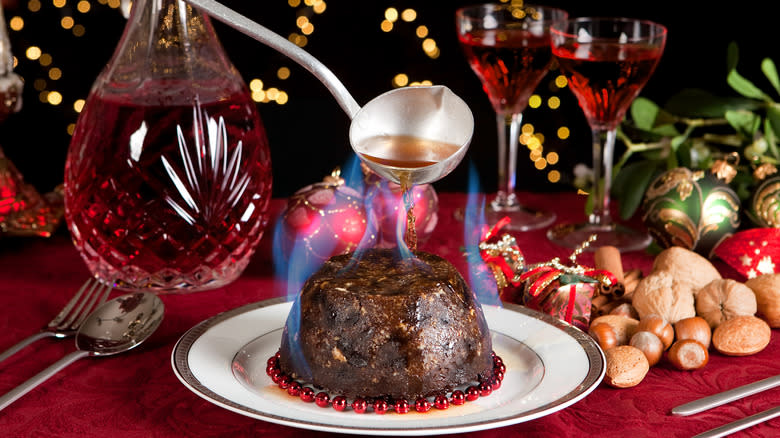
Setting things on fire is usually not preferred in the kitchen, but heat can sometimes bring a lot of flavor. Flambéing is the preferred fiery technique used for sweet and savory dishes. It involves alcohol -- usually potent spirits with high ABV -- that is set alight, creating an eye-catching spectacle for all involved. However, the technique is not only done for the visual element. Setting spirits on fire will release the alcohol and remove all rough edges, leaving only pleasant and nuanced flavors behind. Flambéing was all the rage in the past, but is now neglected and unfairly lauded as a forgotten old-school technique. Any time it is performed, it manages to captivate everyone and cause many sighs across the dining room.
As flambéing is mostly associated with France, it's not surprising that most of these desserts share the same origin, and you'll mainly find them at French restaurants. But these flaming specialties should not only be reserved for fancy establishments. Working with fire seems a bit challenging, but flambéing is not a difficult technique to master and have it ready for your next dinner party.
Perhaps these desserts will inspire you to try it at home and amaze your guests with a fiery spectacle. This is a selection of classic flambéed desserts, and the ranking was based on overall quality, balance of flavors, and textural elements. Though all of them are worth trying, some are simply a tad better than the rest.
Read more: The Most Useless Cooking Utensils, According To Chefs
Baba Au Rhum Flambé
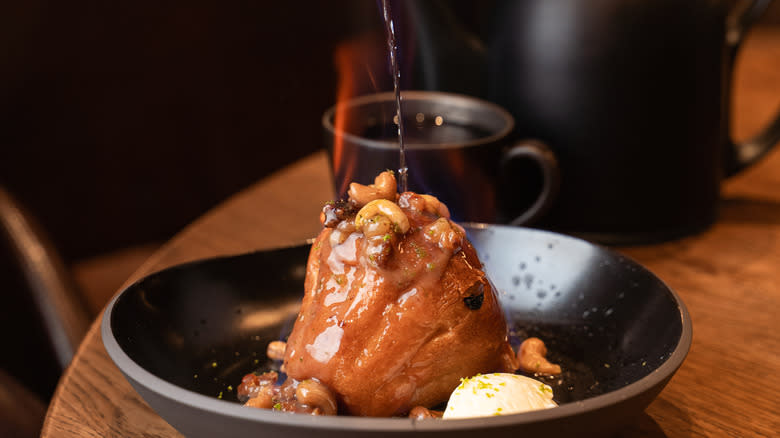
Baba au rhum, also known as rum baba, is a traditional French cake made with light, leavened batter. It is usually baked inside special molds, resulting in a tall cake with a large dome. Rum baba has its origins in central and eastern European pastry traditions. Similar cakes were believed to have been brought via a Polish connection when King Stanislaus I was exiled to France. The exact time and place when rum baba got its current rum-soaked form is unknown, but the most popular theory associates the origin with chef Nicolas Stohrer, who was allegedly the first to make it at the French court. In 1730, Stohrer opened a pastry shop, which still operates and serves classic baba au rhum, along with other perfectly executed French pastries.
The base sponge cake is enriched with eggs and butter. It is leavened with yeast, creating an airy cake that soaks liquid quite well. Usually, the entire cake is dipped in copious amounts of rum, allowing the sponge to soak up all those delicious flavors. Rum baba is not traditionally served flambéed. But, as it is best described as rum-soaked cake, it's not unusual to see the flaming version on the restaurant menus. Due to the dramatic effect, the cake is usually finished and flambéed tableside. Though it takes the last place on the list, rum baba is a well-built and enjoyable cake, but the sometimes overpowering rum profile can be too potent and overly smothering.
Crêpes Mylene
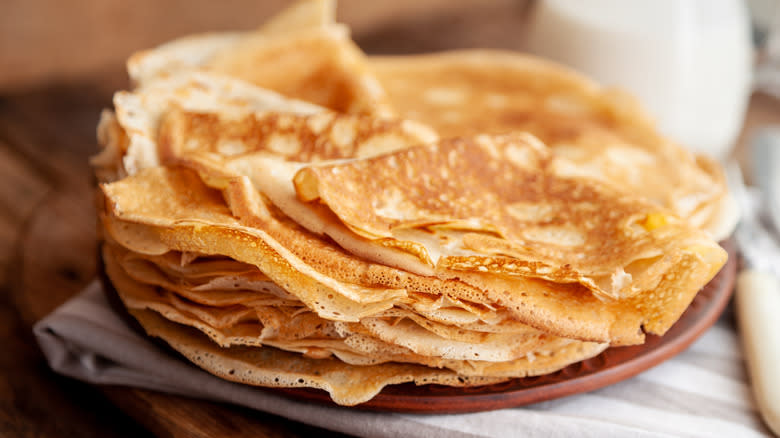
These flambéed crêpes are one of the less familiar French desserts, and though they are not common these days, the combination is part of traditional French cuisine. Crêpes Mylene deservingly finds its place on this list due to the nice balance of sweetness, buttery richness, and fruity aromatics, all complemented by the smooth, alcohol-infused background. Sadly, it is not something contemporary restaurants usually add to the repertoire.
As the name says, this dessert is a variation on crêpes -- thin, traditional French pancakes that come with various fillings and are mostly eaten as a dessert or a sweet snack. This is one of the flamed versions, closely related to the Crêpes Suzette that grew into a more favored flambéed variety. Mylene starts with crêpes that are filled with sliced pears. Neatly packed rolls are placed inside a heated, aromatic sauce that blends orange and lemon juice with sugar and plum brandy. When the pancakes are set and nestled, the sauce is poured over and lit, creating a visual spectacle, and toning down the heat from the brandy. Toasted almonds are usually sprinkled on top to add some textural diversity. This is a nice and enjoyable dessert but perhaps misses some complexity and elegance.
Christmas Pudding
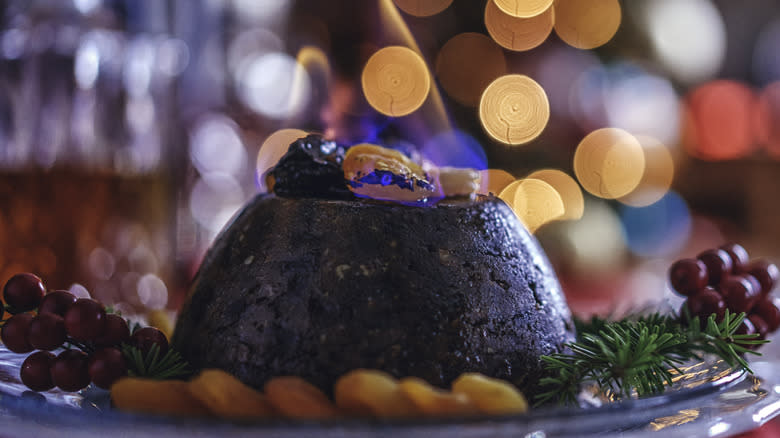
Christmas pudding is a legendary British dessert served as a perfect ending to the festive Christmas dinner. This is a complex and time-consuming specialty, but the work usually pays off as it yields a dark, brawny dessert with a lot of character. Traditional Christmas pudding is made with flour, sugar, eggs, suet, brandy, candied citruses, and a blend of brandy-soaked dry fruit -- raisins and currants are the most common combination. The pudding is usually infused with a hefty amount of warming spices such as cinnamon, nutmeg, and cloves that help to deliver that typical Christmasy profile. The cake is steamed, and as the alcohol acts as a preservative, it can be stored for months. Before serving, Christmas pudding should be heated and flambéed, which creates a perfect fiery finish to Christmas dinner.
Christmas pudding is a concentrated dessert with a medley of flavors and aromas. If you are a fan of dense and robust desserts, this will be right up your alley, but for some, it may be a tad overwhelming. It is a dessert that should be reserved for special occasions, and it is not something that could be eaten every day. To get the most out of Christmas pudding, always serve it warm, preferably with custard, cream, or brandy sauce on the side.
Melting Chocolate Spheres
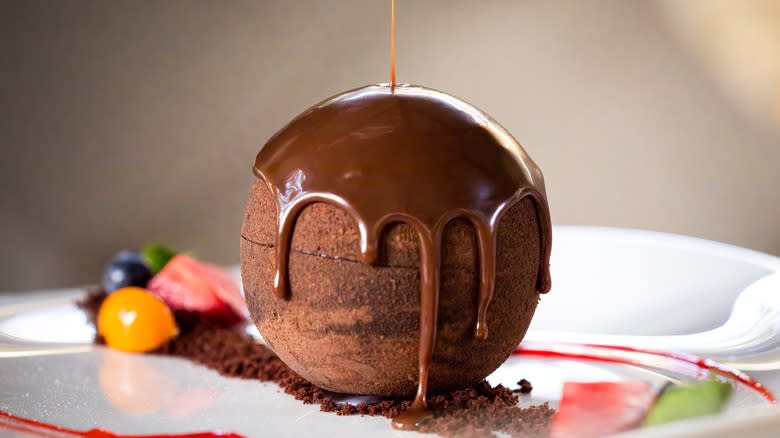
A slightly less traditional dessert on the list comes in the form of a large chocolate sphere that is flambéed, and then allowed to melt directly onto the serving plate. This is a dessert you will find in upscale establishments, and the fiery spectacle is usually performed tableside, creating a theatrical experience for the guests.
These spheres are usually made with dark chocolate, the preferred variety in pastry making due to the more complex character and subdued sweetness. The spheres can vary in size and typically hide an additional element inside. These often include custards, creams, ice cream, fruits, and marshmallow fluff, but more elaborate combinations are not unusual.
There are no guidelines when it comes to alcohol used for flambéing. The choice usually depends on the overall flavors in the dessert and the philosophy that the pastry chef is aiming for. These melting chocolate spheres have a lot of potential, but as there are no rules on what goes inside the chocolate orb, the versions vary from more to less successful. You certainly want something creamy, preferably chilled, that would pair nicely with warm, runny chocolate and the warmth of flambéed alcohol.
Mangas Flambada (Mango Flambé)
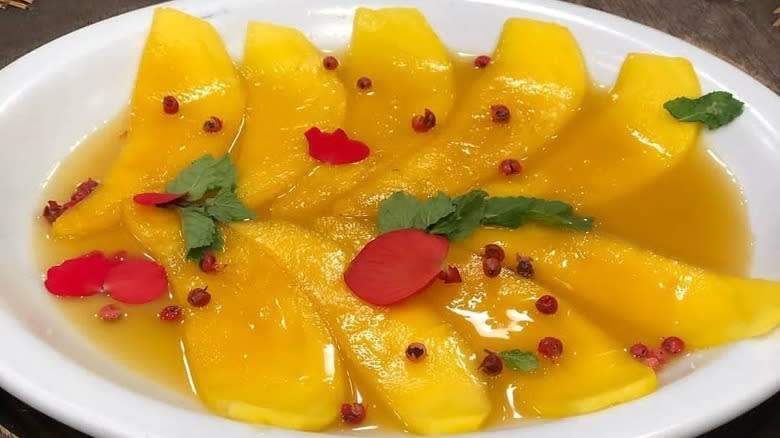
Because fruit is generally refreshing, juicy, and sharp, it is one of the most suitable options for flambéing. Most fruits blend nicely with sweet, caramel-flambéed sauces and lip-smacking alcohol flavors. This version, which you will sometimes see labeled as mangoes diablo, is found in regions where mangoes are abundant and usually picked perfectly ripe.
The recipe is quite adaptable but typically calls for sliced mango, butter, sugar, and high-proof alcohol. The technique involves sautéing mango slices in butter and sugar to create a thick, sticky sauce that is later infused with a spirit of choice -- rum and tequila are perhaps the best and the most common options in this combination. The whole thing is flambéed until the alcohol evaporates but leaves behind all the aromatics. This dessert calls for a complement and best works with ice cream -- preferably classic vanilla. Ideally, in this pairing, mangoes will be served warm as a perfect contrast to the cold ice cream. For this dessert to work, you will need mangoes at their prime. Anything other than that will result in a subpar dessert with not much flavor and not enough sweetness, which means that this flambéed specialty might not always deliver the best results.
Omelette Valée d'Auge
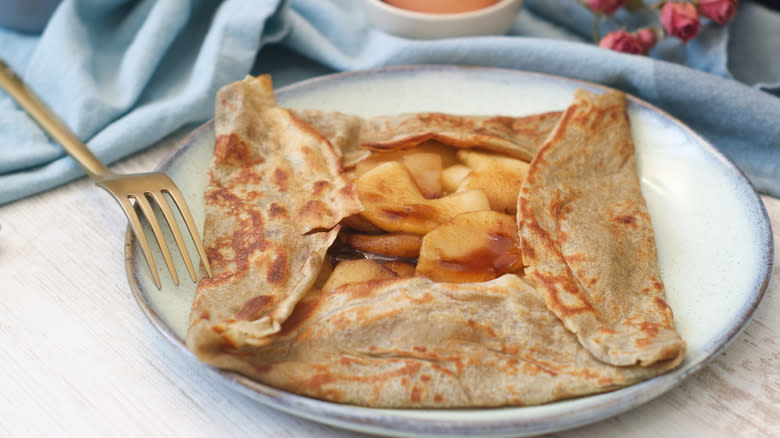
Don't be fooled by the name; though this regional specialty is an omelet variety, it is not the classic savory version. Omelette Valée d'Auge, also known as omelette sucrée à la Normande, is a sweet, egg-based dish that can be enjoyed as a dessert or even a decadent breakfast. The philosophy of this dish reflects its origin and regional character. It hails from Normandy and incorporates apples and Calvados -- the legendary apple brandy -- as two flagship regional products.
The dish starts with apples that are sautéed in copious amounts of butter along with sugar and Calvados, creating a medley of fruity, caramelized flavors. Lightly beaten eggs are then pan-fried and topped with all those buttery apples until the egg base becomes golden and crisp. Flambéing is not a mandatory step, but it provides a nice finish to the whole dish. Naturally, Calvados is the alcohol used for flambéing. An additional dose will help bring out more apple-like flavors in the dish. The omelet is best served with a light sprinkle of powdered sugar or a dollop of crème fraîche. Though this is a beautiful dish, it is slightly reminiscent of an everyday breakfast -- albeit with the addition of alcohol -- and is perhaps missing some complexity and substance to be better positioned on the list.
Peach Flambé
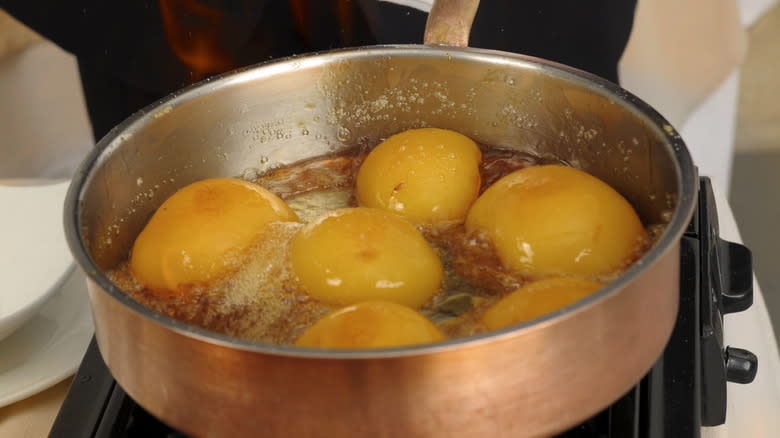
Another fruity version on this list is reserved for sweet, finger-licking peaches stewed in buttery, sweet sauce doused with liquor and lit to enhance all those fruity and caramel flavors. Peaches are an ideal flambéing fruit. They are usually tender and soft but sturdy enough not to disintegrate in a pan filled with bubbling butter and scorching sugar. Peaches have wonderful, blossom-like aromas and sweet honey-like flavor. In combination with other ingredients, this dish becomes a feast for all senses.
Flambéed peaches are easily adaptable. You will see versions with sliced or halved peaches, and while some will remove the peel, others will not. Regarding alcohol, peaches don't really have favorites and can be paired with most strong spirits, but bourbon or rum might be one of its most suitable partners. They also work well with other fruit and can benefit from a touch of orange zest or aromatic orange liqueurs. Like all other fruit flambés, this version requires an additional component and finds its ideal match with neutral-flavored ice cream. Though this is a perfect summer dessert, it does call for more texture to move ahead on the list.
Crème Brûlée Flambé
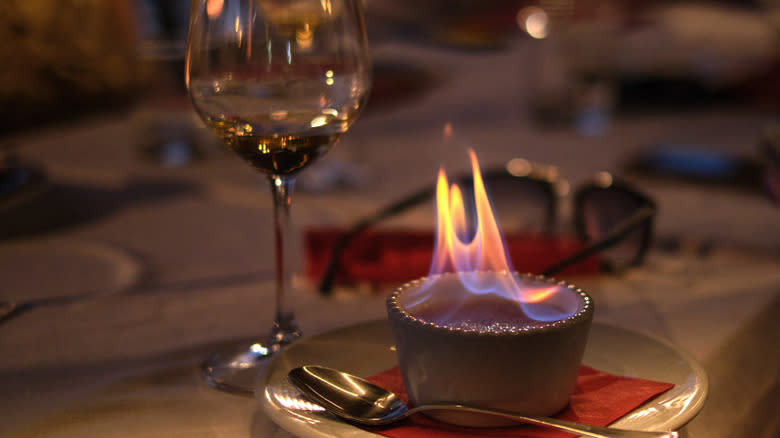
Crème brûlée is a classic. This wonderful custardy creation has long gained international fame and is one of the traditional French desserts you will find in every corner of the world. At its basic, it consists of a silky smooth, vanilla-flavored base topped with a thick, crackly crust made with caramelized sugar. Crème brûlée is not traditionally flambéed -- the sugar is usually melted with a torch -- but it is also not unusual to see it served with a dramatic, fiery garnish.
The best thing about crème brûlée is the contrast between the tender, silky cream and the brittle crust that covers the top and acts as if it protects the decadent custard base. Flambéing should be the last step in the process. Sugar needs to be caramelized and allowed to set before it is drizzled with liquor and set alight. Crème brûlée is a dessert that requires no intervention, but all the brawny flavors left from the alcohol will give this familiar classic a lot of character, and can potentially make a more complex and serious dessert. Without additional flavorings and garnishes, it can sometimes come off as one-dimensional and perhaps a bit uninspiring.
Cherries Jubilee
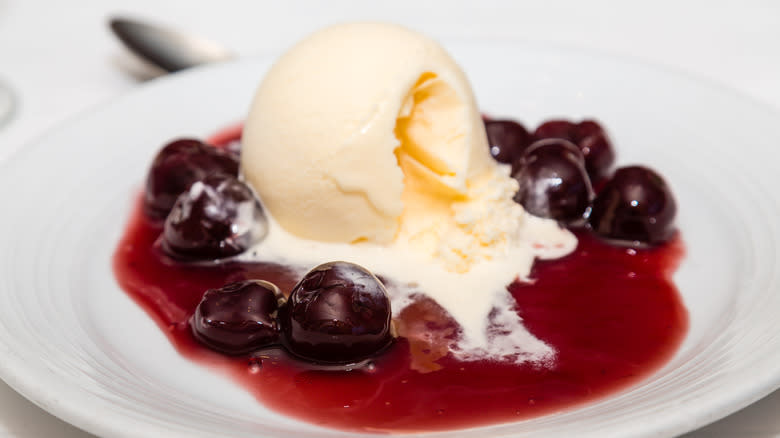
In the magical world of desserts, it does not get more classic than cherries jubilee. This old-school favorite was most likely created by Escoffier for Queen Victoria's diamond jubilee. Surprisingly, for such an important event, Escoffier opted for simplicity and decided to go with poached, brandy-flambéed cherries served in a thick, sticky sauce. Cherries jubilee is a dish that proves Escoffier's brilliance in making incredible dishes with minimum ingredients that can withstand the test of time.
Cherries jubilee has been tweaked and updated in line with contemporary trends, and now it usually combines stewed, flambéed cherries with a dollop of ice cream. The combination is sometimes elevated with cookies or a sprinkle of crunchy slivered almonds that give the dish a textural component. Though rum is nowadays often used to flambé the cherries, the classic version suggests potently fruity cherry brandy for the maximum cherry flavor.
If cherries jubilee was designed for a queen, it's obvious that many will find this juicy, sweet, and subtly tart combination one of the best flaming desserts. Perhaps the beauty is in simplicity and the talent to achieve harmony without elaborate techniques or a long list of ingredients.
Bananas Foster
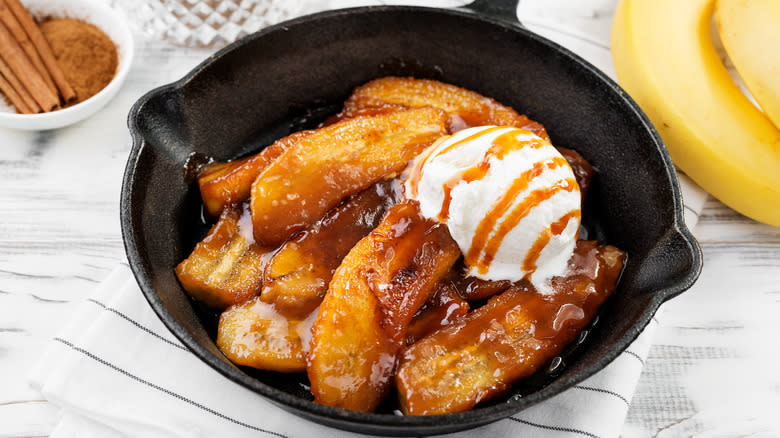
Bananas Foster is one of the best-known American flaming desserts. In the whole realm of fruit-based flambéed desserts, this old-school version is an unprecedented favorite, with the most harmonious relationship between the fruit and gooey, caramelized sauce.
Unlike many other items on this list, the origin of Bananas Foster is well recorded. The combination of flambéed bananas served with ice cream was first whipped up at Brennan's, one of the iconic New Orleans establishments. As the story goes, the dessert was designed to commemorate Mr. Foster, a local businessman who tackled corruption in the city. Classic Bananas Foster is rich and decadent. It involves copious amounts of melted butter and sugar, all spiced with cinnamon, and reduced into a thick caramel sauce that blankets the bananas. The dish is usually finished tableside with a splash of flambéed rum that lends all its potent aromatics to the sauce.
This combination simply works well together. As bananas are usually of decent quality, you rarely get mediocre versions, and most locations that serve this vintage special know how to attain that perfect mélange of sweetness, heat, and spice, all coated in a heap of buttery flavors.
Baked Alaska
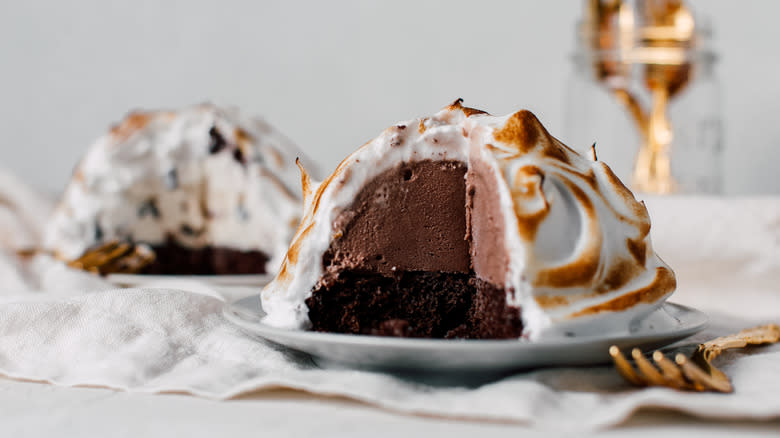
Baked Alaska is perhaps the most popular flaming dessert. In its classic form, this vintage specialty consists of a sponge cake base topped with different ice cream flavors, all coated in a thick layer of feather-light meringue that is torched or flambéed to gain beautiful, charred specks that supply subtle caramel flavors. Baked Alaska is a grandiose dessert with a rich history that always evokes a nostalgic feel for the times gone by.
There is a lot of disagreement when it comes to its origin. While one side claims it was created at the New York-based Delmonico's, others theorize that the first version came from Antoine's Restaurant in New Orleans. However, most agree that it probably originated in the 19th century when the U.S. acquired Alaska from Russia. The theory is mainly accepted as the whole dessert mimics the ice-cold, snowy Alaskan territory.
Baked Alaska is not here only because of this nostalgic feel. This is a glorious, eye-catching dessert that captivates with its appearance. The thick, chewy sponge, soft and gooey ice cream, and the layer of sweet, toasty meringue create fabulous textual diversity that not many desserts can match. Along with the playful difference in temperature and the possibility to easily adapt the flavors, baked Alaska is a cut above most traditional desserts, and is incredibly successful in remaining loved and relevant despite its advanced age.
Crêpes Suzette
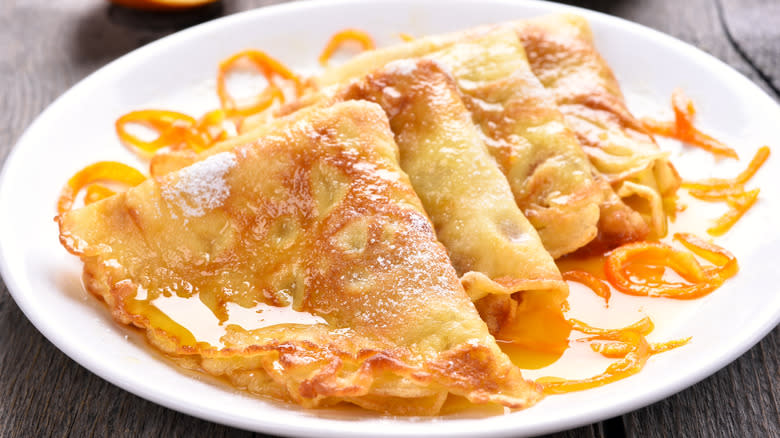
Crêpes Suzette is the clear winner in the category of flambéed desserts. Elegant, classic, and intensely flavored, this combination of thin, crispy pancakes doused in boozy, orange-flavored sauce is one of the jewels of traditional French cuisine. Crêpes Suzette is a dessert with a seductive character that will swoon you over, and you will eagerly wait for another chance to try it.
French crêpes are the base of this dish. These large pancakes should be delicate but retain some chew and preferably develop a lacey crust around the edges. The accompanying sauce has a silky smooth, lightly caramelized butter base, thoroughly infused with lemon and orange zest. The boozy moment used for flambéing is gained with the addition of orange-flavored spirits and liqueurs such as Grand Marnier, Curaçao, or triple sec. Pancakes are folded and smothered while the sauce is still warm and brimming with aromas. Though this dish is perfect as is, a dollop of vanilla ice cream or several segmented oranges is always a lovely complement.
Crêpes Suzette is a refined dessert showcasing skill, finesse, and the perfect balance of flavors, textures, and aromas. Paired with the movie-like flambéing technique, this time-honored combination will never go out of style. If you need to have one classic flambéed dessert, Crêpes Suzette is a no-brainer.
Read the original article on Mashed.

